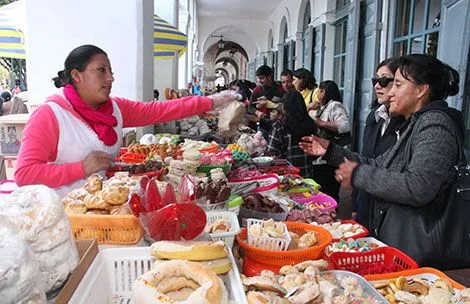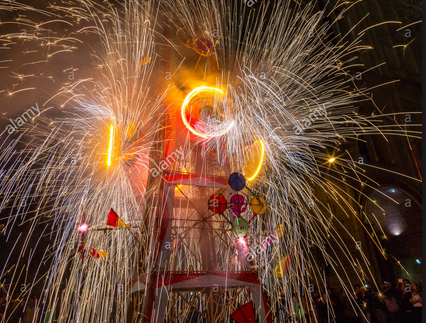With bombs bursting in air and lots of sweets, Corpus Christi celebration is noisy, fattening and fun

Fire it up! A “vaca loca” gets the party going on Mariscal Sucre.
By Sylvan Hardy
Get ready for fireworks, cookies, candy, honey bees, and general craziness.
Cuenca’s Corpus Christi celebration, commonly known as Septenario or Setenario, kicked off yesterday with a Catholic mass and procession followed by the sales of pastries, culminating in a fireworks show in Parque Calderon. Centered around Parque Calderon, Corpus Christi is the city’s most explosive and calorific event of the year, drawing tens of thousands of customers and spectators.

A fireworks “castle” in Parque Calderon.
As Septenario implies, the event is scheduled for seven days but it is often extended a day or two by government order if sponsors pony up the cash for additional fireworks displays. This year, event organizers hope to extend the celebration until June 10.
Septenario is a celebration contrived by the Catholic Church following the Spanish conquest to replace the indigenous June solstice observance. Despite the fact that it coincides with the Corpus Christi observance and is sponsored in part by local churches, most of the festival bears little connection to Christian piety.
As it has in the past, the church goes to great pains to point out the festival’s religious heritage — it was first observed in Belgium in 1264 — holding special Corpus Christi masses at half a dozen city churches.
In addition to nightly fireworks shows, the festival is famous for the sale of sweets. This year, 120 hundred candy and pastry stands will line Calles Sucre, Malo, Bolivar and Cordero, each under its own canopy with tables piled high with candy, pastries and cookies. Besides attracting customers, the sweets are also popular with honey bees. Buyers beware!

Septenario sweets for sale on Luis Cordero.
The festival is best known for the nightly fireworks in which 30- to 40-foot bamboo towers, called castles, are rigged with fireworks and placed in the streets around Calderon Park. Depending on the night, there may be two, three or four castles, each sponsored by a church, civic organization or family.
The towers are set off at intervals determined, apparently, on the whim of the pyromaniacs in charge. Typically, the towers’ explosives are sequenced to begin slowly. First, sparks fly from the tower’s lower level, blanketing the street around them. Then, burning pin-wheels gyrate, throwing off more sparks and lots of smoke. As the higher elevations of the towers ignite, firecrackers explode in a deafening rapid-fire and rockets hurtle into the sky.
The amount of fireworks allowed on each castle was reduced in 2012 following a fire that caused millions of dollars damage to the seminary next to the cathedral. Investigators blamed the fire on errant fireworks, leading to the restrictions. At one point, city officials considered banning fireworks entirely in the historic district but protests from sponsors and vendors led to a compromise. Although the explosions are not what they used to be, most onlookers don’t seem to mind.

Another castle goes up in sparks.
By municipal order, this fireworks shows in this year’s celebration must be completed by midnight.
According to historians, Septenario began in Cuenca the year of the city’s Spanish founding in 1557 under the auspices of the church and in the name of Corpus Christi, which begins on the Thursday after Trinity Sunday. In Ecuador, the celebration is much more popular in the highland provinces. Different towns in the region celebrate Septenario according to local tradition.
While Cuenca is known for fireworks and candy, other towns emphasize costumes, music and dancing. In Cotopaxi Province, masked dancers try to climb 12-meter greased poles.
Beside the fireworks at Calderon, neighborhoods around Cuenca sponsor their own parties, complete with indigenous dances, costume competition, and, of course, fireworks.
Fireworks begin nightly after dark. Pastries and candy are on sale during the day.





















